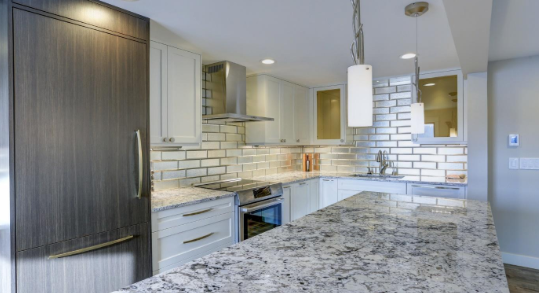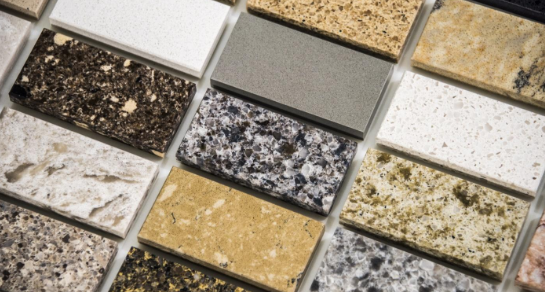Quartzite is a natural stone, made in the earth through a process of high heat and pressure, and let’s just say, it’s pretty darn durable. If we’d have to give you a recommendation for your kitchen or bathroom countertop, and you knew you were going to really put some wear and tear on the surface you chose, we’d tell you to highly consider quartzite.
But you can’t go on that information alone; you can’t make a countertop decision simply because we recommended you do that. That’s not enough to win you over as a homeowner.
So, that’s what we’re going to do here. We’re going to fill you in on some interesting facts that you may not know, and by the end of it, we hope that your swayed to choose this magnificent option.
Let’s dive right in.
“The Look” of Quartzite is Incredible
The base color the natural stone countertop option is typically white or cream, but it can drift off into the beige color tones, too.
The look of quartzite does not stop there, though. According to many manufacturers and installers of the product, quartzite resembles the look of marble, but with a few additional perks.
Generally speaking, the surface slabs tend to lean towards the whites or the greys – but there are hints of other colors in each unique piece of quartzite. If you’re lucky, you’ll catch shades of pink, red, yellow, green, blue, and even orange, depending on the minerals that are present throughout the rock.
How does the color variation change with every slab? Well, that would depend on several factors. For starters, the amount of iron oxide present in the solid surface may alter the color a tad. Also, the different areas of the region that the stone comes from and the age of the stone may play a part in what color the quartzite officially ends up becoming.
You Have Options with the Finish
We get it, almost every kitchen and bathroom countertop offer different finishing looks – but quartzite is something special.
If you want a honed finish that shows off a matte-like look to liven the countertop up (and make it more modern), you have that option. If you want to go with the classic, shiny look, get it polished. And, if you want to lean towards a new finishing technique, like leathering, that’s okay, too!
At least you have options – we’d suggest bringing a few of these options home to try out before settling on a countertop.
You’ll Need a Sealer
Quartzite is a porous surface – we can’t lie about that. However, the porosity of the stone will depend on the type of quartzite you pick. For instance, some may react to acids, whereas others may not be phased by them.
We recommend sealing your quartzite countertops with a penetrating, or impregnator, sealer. This is extremely important to keep your surfaces safe from grease and oil stains – but the sealing will not completely defend the stone against acid etching (we’ll get to that).
For daily upkeep, we’d say always clean up a spill whenever it happens, immediately. And, washing the surface down with a damp cloth and some mild dish detergent wouldn’t hurt, either.
Acid Etching is No Good
One thing that’s good to know about quartzite is that no two slabs are ever the same – they’re not all created equally, ladies and gentlemen.
For instance, certain quartzite tablets are prone to acid etching, whereas others are not.
That’s why, once again, we recommend taking a small sample home to test out before settling on the option you’d like to install in your kitchen or bathroom – better safe than sorry!
Quartzite Compared to Granite: The Details
As far as similarities go, both quartzite and granite are formed deep within the layers of the earth – and both by pressure and high amounts of heat. This makes both surfaces extremely hard and sturdy.
However, quartzite wins the battle in this department. It’s true; quartzite weighs in a little bit higher on the durability scale.
Now, onto the differences.
Granite typically has darker flecks spread out over the surface – this is due to the rock being formed from molten lava. On the other hand, quartzite doesn’t usually have any dark spots whatsoever – as it resembles marble and the characteristics of the delicate and soft countertop option.
To boot, quartzite wins the battle for density and porosity, too, as it can withstand certain conditions better than granite slabs can. To be fair, both countertop options are porous to some extent, but quartzite can have different levels of withstanding spills.
Quarts vs. Quartzite: Which is Better?
Quartz and quartzite have A LOT of differences – the major one being that quartz is a man-made, engineered material containing resin and polymers, and quartzite is a natural stone formed when sand is exposed to high heat levels and then compressed within the earth’s surface.
Quartz can be more cost-effective, but quartzite is not the most expensive countertop option by any means.
To boot, quartzite is pretty impermeable to heat and scratches – especially considering it was made under such hot temperatures and could withstand difficult environment changes. Quartz may be more flexible, but it will definitely chip a lot more than the natural stone known as quartzite.
To be fair, quart does have a lot more color options, seeing as the company that constructs the material can add pretty much any color pigment you’d like to the engineered stone. That means, you can make the slab look extremely natural, or you can go all out, pick a trend, and roll with it.
Quart is also 100% non-porous, making it less prone to stains and bacterial growth – hey, we’re just laying out all the facts for you.
If you’re looking for even more information, please visit slab market – maybe that will help you make the right decision.
We hope you enjoyed our little fact guide on quartzite today! And, we really hope that the kitchen countertop of your dreams is a little bit closer to making its way into your home.









